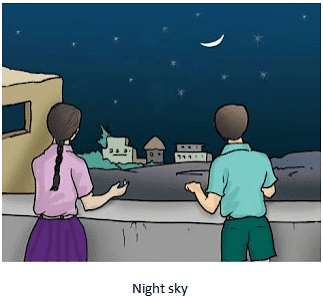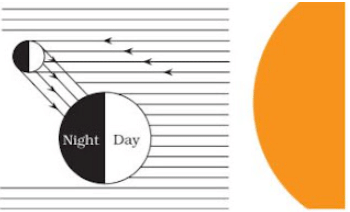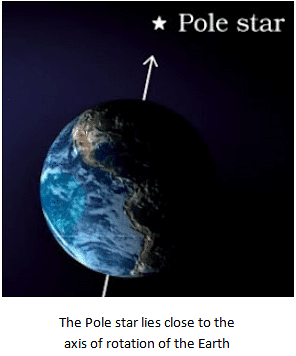Class 8 Exam > Class 8 Notes > NCERT Textbooks & Solutions for Class 8 > NCERT Summary: Stars & the Solar System
Stars & the Solar System Summary Class 8 NCERT Summary
Introduction

- The moon is the brightest object in the night sky.
- All natural objects like the stars, the planets, the moon and many other objects in the sky are celestial objects.
The Moon

- The various shapes of the bright part of the moon as seen during a month are called phases of the moon.
- New Moon day → when moon is not visible
- Full Moon day → when full moon is visible
- Gap between consecutive new moon day and full moon day is of 15 days.
- Rotational period and revolution period of moon are the same (almost 29 days).
Moon’s surface

- Because of lack of atmosphere, one cannot hear any sound on moon.

- Moon is visible due to reflected sunlight
The Stars
- All stars emit their own light. They appear small because of large distances from the earth.
- The sun appears bigger because it is nearer than any other stars on the space.
- In day time, stars are not visible because of bright sunlight.
- Stars appear to move from east to west because of earth’s rotation from west to east.

- Pole star does not appear to move because it is very nearly situated on earth’s rotational axis over the North pole.
Constellations

- The stars forming a group that has a recognizable shape is called a constellation.

- Ursa Major also known as the Big Dipper, the Great Bear or the Saptarshi is one of the most famous constellations during summer time.
- Orion also called the Hunter is another well-known constellation that can be seen during winter in the late evenings.
Solar System

- The Sun and the celestial bodies which revolve around it form the solar system.
- Sun is the nearest star from the earth.
- It consists of large number of bodies such as planets, comets, asteroids and meteors.
- The gravitational attraction between the Sun and these objects keeps them revolving around it.
Planets
- Stars twinkle in the night sky, but planets do not.
- Planets revolve around the sun along definite paths, called orbits.
- Time taken by a planet to complete one revolution of its orbit is called revolution period.
- Time taken by a planet to rotate about its axis is called period of rotation.
Satellites revolve around planets.
Inner planets
Mercury
- Nearest planet to the sun
- It is seen just before sunrise and just after sunset near horizon. It has no satellite.
Venus
- Nearest planet to the earth
- Brightest planet in the night sky
- Seen in the eastern sky before sunrise and in the western sky after sunset
- Also known as morning or evening star
- Has no satellite and rotates from east to west (sun rises in the west of Venus).
Earth
- From space, it appears blue because of 75% water content.
Mars
- It appears reddish and therefore, is known as red planet.
Outer planets
Jupiter
- Largest planet in the solar system
- Rotates very fast about its axis and has large numbers of satellites
Saturn
- Has prominent ring system and large numbers of satellites
- Its density is less than water and is the least among the planets
Uranus and Neptune
- Both have ring system.
- Uranus has a tilted rotational axis and appears to roll on its side.
- Uranus rotates from east to west similar to Venus.
Other members of Solar System
Asteroids
- Small rocky objects found in large numbers between Mars and Jupiter
Comets
- Highly elliptical objects
- Have a bright head and long gaseous tail.
- Tail is always directed away from the sun.
- Halley’s comet appears after every 76 years.
Meteors & Meteorites

- Objects that enter the earth’s atmosphere and burn because of friction with the atmosphere
- Large meteors that reach earth’s surface are called meteorites.
Artificial satellite

- Revolves around the earth
- Used for weather forecasting, remote sensing, communication system, etc.
The document Stars & the Solar System Summary Class 8 NCERT Summary is a part of the Class 8 Course NCERT Textbooks & Solutions for Class 8.
All you need of Class 8 at this link: Class 8
FAQs on Stars & the Solar System Summary Class 8 NCERT Summary
| 1. What are stars made of? |  |
Ans. Stars are primarily made up of hydrogen and helium gas. These gases undergo nuclear fusion reactions in their core, which produce energy and heat. Other elements, such as carbon, nitrogen, oxygen, and iron, may also be present in smaller quantities.
| 2. How do stars form? |  |
Ans. Stars form from massive clouds of gas and dust called nebulae. Gravitational forces cause these clouds to collapse inward, increasing the density and temperature. When the core of the collapsing cloud becomes hot and dense enough, nuclear fusion reactions begin, and a star is born.
| 3. How do stars die? |  |
Ans. Stars can die in different ways depending on their mass. Low to medium mass stars, like our Sun, eventually run out of hydrogen fuel and start fusing helium. As they exhaust their nuclear fuel, they expand into red giants and then shed their outer layers to form planetary nebulae. The remaining core becomes a white dwarf. High mass stars, on the other hand, undergo a supernova explosion, leaving behind either a neutron star or a black hole.
| 4. How do we measure the distance to stars? |  |
Ans. Scientists use a variety of methods to measure the distance to stars. One common method is parallax, which involves observing the apparent shift in a star's position as the Earth orbits the Sun. By measuring this shift, astronomers can calculate the star's distance. Other methods include using the brightness and temperature of stars, as well as their luminosity and spectral characteristics.
| 5. Can stars collide with each other? |  |
Ans. While stars are relatively far apart in space, it is possible for them to collide under certain circumstances. In denser regions like stellar clusters and galaxies, close encounters between stars can lead to gravitational interactions that may result in stellar collisions. These collisions can have significant effects on the stars involved, altering their structures and potentially leading to the formation of new stars.
Related Searches

















